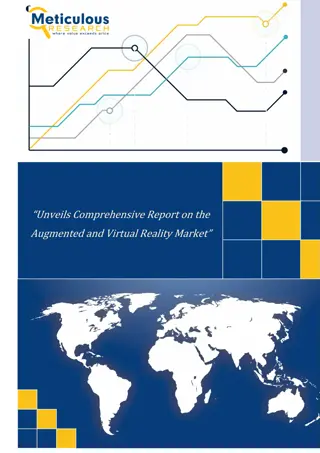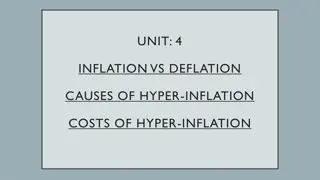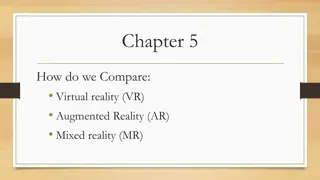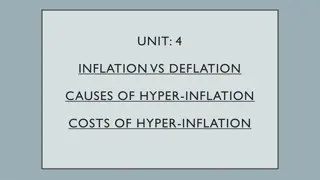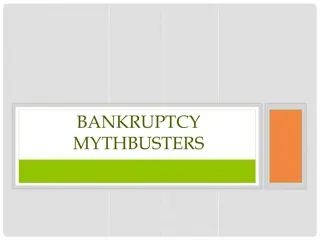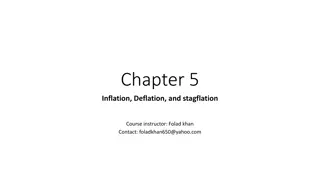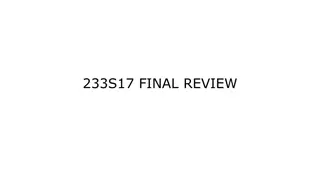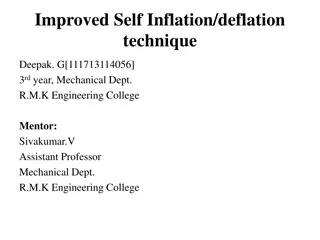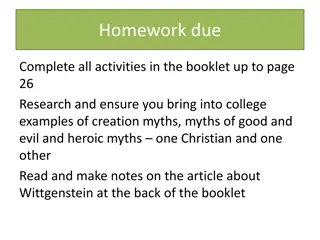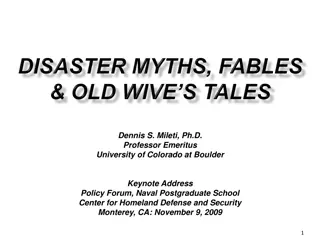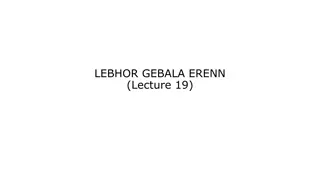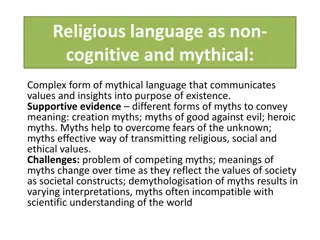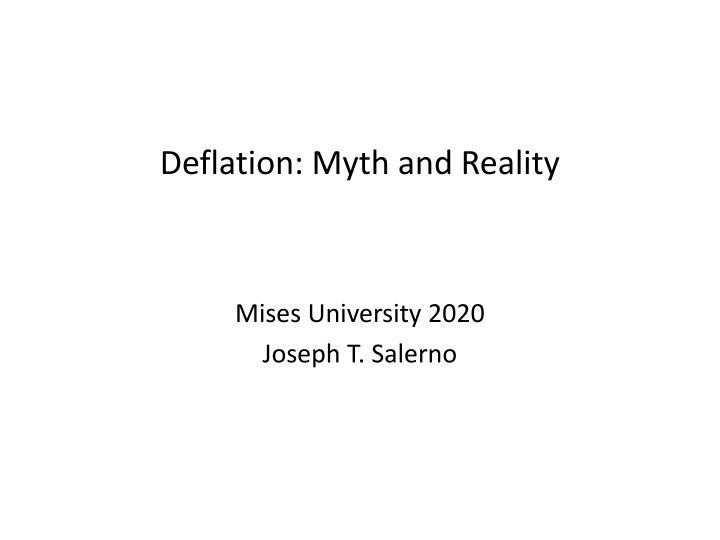
Deflation: Myth, Reality, and Economic Fear
Explore the evolution of the meaning of deflation from the 19th century to modern times, debunk deflationphobia promoted by central bankers, and learn insights from Ben Bernanke and Alan Greenspan on addressing deflation concerns. Discover the causes of deflation and its impact on the economy.
Download Presentation

Please find below an Image/Link to download the presentation.
The content on the website is provided AS IS for your information and personal use only. It may not be sold, licensed, or shared on other websites without obtaining consent from the author. If you encounter any issues during the download, it is possible that the publisher has removed the file from their server.
You are allowed to download the files provided on this website for personal or commercial use, subject to the condition that they are used lawfully. All files are the property of their respective owners.
The content on the website is provided AS IS for your information and personal use only. It may not be sold, licensed, or shared on other websites without obtaining consent from the author.
E N D
Presentation Transcript
Deflation: Myth and Reality Mises University 2020 Joseph T. Salerno
The Changing Meaning of Deflation 19thcentury: A decrease in the supply of money in the economy. Period. Early 20thcentury: a change in the money supply that is insufficient to serve the expanding needs of trade, resulting in a general fall in prices. Modern definition: a decrease in the price level (CPI, PCE).
The Meaning and Uses of Deflationphobia A morbid and irrational fear of falling prices Central bankers promote this fear among the public to justify more inflationary monetary policy. Federal Reserve officials promoted the spread of deflationphobia by making obscure and ominous statements (Fedspeak) in the 2002 when inflation was low (1.6%).
Ben BernankeFedspeak Deflation: Making Sure It Doesn t Happen Here (Speech, November, 2002): [T]he chance of significant deflation in the United States in the foreseeable future is extremely small . . . .[T]he Fed would take whatever means necessary to prevent significant deflation in the United States and ... has sufficient policy instruments to ensure that any deflation that might occur would be both mild and brief. . . . So having said that deflation in the United States is highly unlikely, I would be imprudent to rule out the possibility altogether.
Alan GreenspanFedspeak Congressional testimony, April 2003: A further drop in inflation would be an unwelcome development. [W]e see no credible possibility that we will at any point . . . run out of monetary ammunition to address problems of deflation.
The Media Promote Deflationphobia Financial writers, media commentators, celebrity economists, and think tanks vigorously promoted the central bank message with articles and blog posts with lurid titles: The Deflation Monster Still Lives The Specter of Deflation Why We Should Fear Deflation The Deflation Boogey The Greatest Threat Facing the U.S. Economy: Deflation Defeating Deflation The Deflation Dilemma: To Be Concerned or Not to Be The Deflation Monster Still Lives The Specter of Deflation Why We Should Fear Deflation The Deflation Boogey- -man Haunts Fed The Greatest Threat Facing the U.S. Economy: Deflation Defeating Deflation The Deflation Dilemma: To Be Concerned or Not to Be man Haunts Fed
What Causes Deflation? Like the price of any other good, the value of money is determined by Supply and Demand. An increase in the value of money or falling prices is caused by a decrease in the supply of money or an increase in the demand for money. 1. People increase the demand for money when: 1) they produce and sell more goods for money; or 2) they wish to hold more money and spend and invest less. 2. The money supply decreases when the central bank (the Fed) reduces the total amount of currency and bank reserves in the economy or banks fail, causing depositors checking and saving accounts to disappear. This rarely occurs in the modern world.
Kinds of Deflation There are 3 basic kinds of deflation: 1) Growth deflation 2) Cash-building/speculative deflation 3) Confiscatory deflation governments demonetizing currency notes or limiting withdrawal of cash from banks by depositors The first two kinds are a natural outcome of the free market economy and promote economic growth but the third infringes on property rights and distorts the economy.
Deflation: Myth and Reality 1 Myth: If the money supply does not grow fast enough, prices will fall and stifle economic growth. Reality: Falling prices are the natural and benign effect of rapid economic growth in a dynamic capitalist economy where technology is improving and capital investment is growing and the expansion of the money supply is restrained by a market-based money like the gold standard.
Growth Deflation Caused by an increase in the production and supply of goods and services in the economy, that is, economic growth. Rapid economic growth is caused by increased investment in capital goods and technological progress, which reduce production costs and increase profits. The increased supply of goods causes greater competition for $ by sellers, and therefore increases the exchange demand for money. If money supply increases very slowly, this will result in an increased value of money and falling prices so deflation
History of Deflation in the U.S. Growth deflation occurred in U.S. and other market economies throughout the 19th century. The economic growth rate exceeded the growth rate of the money supply under gold standard. It was good deflation because it was a natural part of the process of economic growth Example: U.S. 1880 to 1896: Prices fell by 30% or 1.75%/yr. Real GDP grew by 85% or 5%/yr.
Prices , Income, and Consumption 1870-1898 Wholesale prices dropped 34 percent, a 1.7 percent annual rate of decline, and consumer prices fell 47 percent, or 2.5 percent annually. Real gross national product grew 4.5 percent each year. Consumption per capita jumped 2.3 percent a year.
Computers Mainframe computer: $4.7 million in 1970; today PCs are 20x faster and with more memory sell for less than $500 with accessories 1980-1999: PC prices fell by 90% but the industry grew 1980 490,000 PCs shipped 1999 43 million shipped 2013 315.9 million shipped. PC memory prices: 1980: $6.48 /Mbyte 2014: <$0.01 ($0.0085)/Mbyte
HDTVs 2004: 32 million television sets sold in North America for an average price of $400 with an average size of 27 inches. 2015, 44 million sets sold in North America, with an average price of $460 and an average size of 38 inches. Price per diagonal inch fell from $14.81 to $12.10 Long-term fall in prices of HDTVs: 1990--$36,000; 2003--$3,000 to $5000; today--<$500.
Laser Eye and Cosmetic Surgery Lasik eye surgery: 1998, $4000 per eye; 2013, $300 per eye. Botox treatment: 2001, $365; 2013, $99-$149 on discount websites Liposuction 1992, $1,622; 2013, $999 on discount websites
Deflation: Myth and Reality 2 Myth: Deflation prolongs and intensifies recession and turns a mild recession into a great depression. Reality: Deflation is the cure for recession and speeds up the recovery of the economy. It prevents recessions from degenerating into depression.
Deflation Adjusts Costs to Prices Businesses increase cash holdings during recessions, because production costs such as wages and other input prices have risen too high during the inflationary boom and wiped out profit margins. They are speculating that wage rates will soon fall back to normal levels. Entrepreneurs would rather hold cash and wait until wages and other costs adjust to the reduced product demand and prices before they begin to invest again Deflation speeds up the readjustment of input prices to output prices and restores the profitability of investment which is the real stimulus for an economy in recession
Deflation Shortens Recessions Households desire to hold more money during recessions as a precaution against wage cuts, job losses, a more uncertain future or because they expect consumer prices will fall in the future. Example: housing and auto prices after the financial crisis of 2007-2008. Only when prices fall to their expected levels will business and household demand and spending begin to increase again If government and central bank policies prevent the fall in wages and prices, then the price/cost adjustment does not occur and the recession and hoarding drags on even with ZIRP and QE Fed policies in force.
The Forgotten Depression of 1920-1921 Inflationary Boom, 1915-1919 1915-1919: Fed increased the money supply by 15.5% per year 1916-1920: U.S. product prices (GDP deflator) rose 15.4% per year 1917-1920: consumer prices (CPI) increased 14.1 % per year
The Forgotten Depression of 1920-1921 Deep Depression nominal GNP fell 24%, from $91.5 billion in 1920 to $69.6 billion in 1921 real GNP shrank by 9% between 1920 and 1921 Unemployment reached 15.3% in 1921.
The Forgotten Depression of 1920-1921 Steep Deflation Money supply grew 2.9% per year in 1920 Money supply declined 7.5% per year in 1921 General prices fell 16.6% in 1921 and 8.1% in 1922 Consumer prices fell 10.9% in 1921 and 6.3% in 1922 Wholesale price fell 56% from mid-1920 to mid 1921 Wages fell 11% over the two years 1920-1921 James Grant, The Forgotten Depression 1921: The Crash That Cured Itself, Simon and Shuster, NY, 2014
Two Depressions Compared Recovery: Deflation and laissez-faire government policy quickly cured the depression. The depression ended by August 1921, only 18 months after it had begun. The Great Depression lasted from 1929-1940 Reasons: government interference with labor markets (minimum wage, forced collective bargaining); product markets (price supports for farm products); money (destruction of the gold standard, devaluation, monetary expansion), higher taxes and more regulations on business; and higher tariffs.
The Keynesian View of the 1920-21 Depression Modern Keynesians cannot explain and are surprised by the swift recovery from the deep 1920-21 depression. The downswing . . . was severe . . . but relatively short. Its outstanding feature was the extreme decline in prices. . . . Government policy to moderate the depression and speed recovery was minimal. The Federal Reserve authorities were largely passive. . . . Nor was any use made of fiscal policy. . . . [T]he Federal budget was deflationary while the downswing was in progress. Despite the absence of a stimulative government policy, however, recovery was not long delayed. (Robert A. Gordon, 1974)
Myths and Reality 3 Myth: the empirical evidence indicates a strong link between deflation and depression Reality: aside from the Great Depression (1929-34), there is no empirical evidence of a link between deflation and depression. The Great Depression is an outlier in major empirical studies that show no statistically and economically significant link between falling prices and falling real output. Deflationphobia of modern mainstream economists like Greenspan, Krugman, Bernanke, Yellen, etc. rests solely on the experience of the Great Depression in the U.S. and a few other countries
Empirical Studies of Deflation-Depression Link 1 Andrew Atkeson and Patrick J. Kehoe, Deflation and Depression: Is Their an Empirical Link? AER Papers and Proceedings 94 (May 2004) Atkeson and Kehoe studied 16 countries over 100 years or more, broken into 5-year periods and covering 73 deflation episodes and 29 depression episodes.
What the Study Found Excluding the Great Depression, Atkeson and Kehoe find that 65 of 73 deflation episodes involved no depression while 21 of 29 depression episodes were not associated with deflation. In other words, 90 percent of deflation episodes did not result in depression.
The Authors Conclusion Atkeson and Kehoe conclude: The data suggest that deflation is not closely related to depressions. A broad historical look finds more periods of deflation with reasonable growth than with depression, and many more periods of depression with inflation than with deflation. Overall the data show virtually no link between deflation and depression.
Empirical Studies of Deflation-Depression Link 2 Pavel Ryska, Deflation and Economic Growth: The Great Depression as the Outlier, QJAE, 20/2 (2017). A more comprehensive study than Atkeson/Kehoe study Ryska studied 20 countries from 1804 to 2015. Using annual data, there are 3,293 observations with reading for both price and output growth. 72% of all annual observations saw positive inflation and 28% saw either zero or negative inflation (deflation).
Results The average annual output growth rate for inflationary years was 2.85% and for deflationary years 2.73%. However, the difference between the growth rates in inflationary and deflationary years was not statistically significant at any level of significance, nor was the difference in the variances of output growth in the two cases.
Ryskas Regression Analysis Ryska develops a regression model using this data set in which output growth is the dependent variable and the independent variable is inflation/deflation. He finds that inflation does have a statistically significant effect on output growth. However it is not economically significant. According to his model, it would take a 17 percentage point increase in inflation to increase real output by 1 percent, which is close to the estimate of the Atkeson/Kehoe study. Using the same model for the Great Depression data (1929-34) does yield a statistically and economically significant effect of inflation on output growth.
Ryskas Conclusion [T]he Great Depression stands out as the only episode in the sample with both a statistically significant and economically important (positive) relationship between output and prices. When one leaves out the Great Depression, which represents only 90 out of 2158 observations used in the regressions, correlations between inflation and output growth in the rest of the sample lose their significance entirely.
Confiscatory Deflation: The Case of India India s Demonetization program Cash is used in 90% of transactions. 86% of the cash in circulation exists in the form of two banknotes, the 500 (roughly $7.5 USD) and 1000 (roughly $15 USD) bills. Nov. 8, 2016, these two notes were declared by gov t no longer legal tender. People forced to go to bank and exchange notes for deposit credits. They could also withdraw money from their accounts in the form of valid bills. But the RBI placed limits for both of these mechanisms. Justifications included (a) eliminating black money; (b) reducing the prevalence of counterfeit currency, which is allegedly used to fund terrorism. Long lines and economic disruption as people did not have access to money for a long period of time.
Inflationary Bubble or Deflation While the Fed and the mainstream media were fear of inflation, Fed monetary policy was creating massive bubbles n housing and financial markets. From the beginning of 2001 to end of 2005, the Fed increased the money supply by about 50%, from $4 trillion to $6 trillion, an average about $750 million to $1 billion per week depending on which monetary aggregate you use.
The Feds Unconventional Monetary Policies since 2009 1. 2. Three rounds of quantitative easing 2009-2014. Credit easing purchasing toxic MBS and long-term government bonds to lower long term interest rates. A massive expansion of the Fed s balance sheet from $800 billion to over $4 trillion. Zero interest rate policy that has devastated savers and insurance companies and pension funds. Another massive increase in the money supply. 3. 4. 5.




